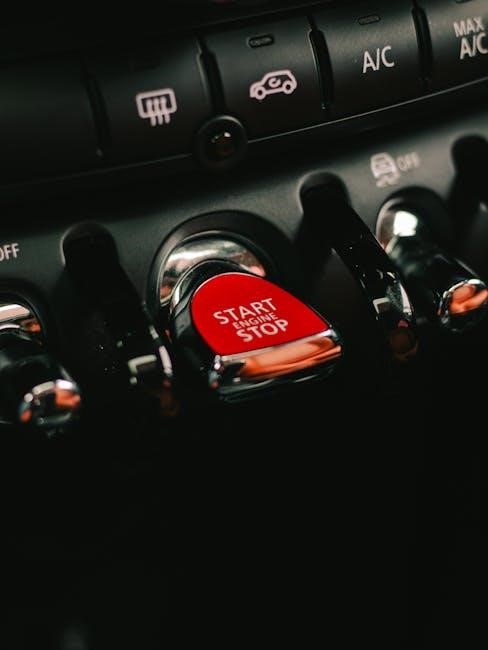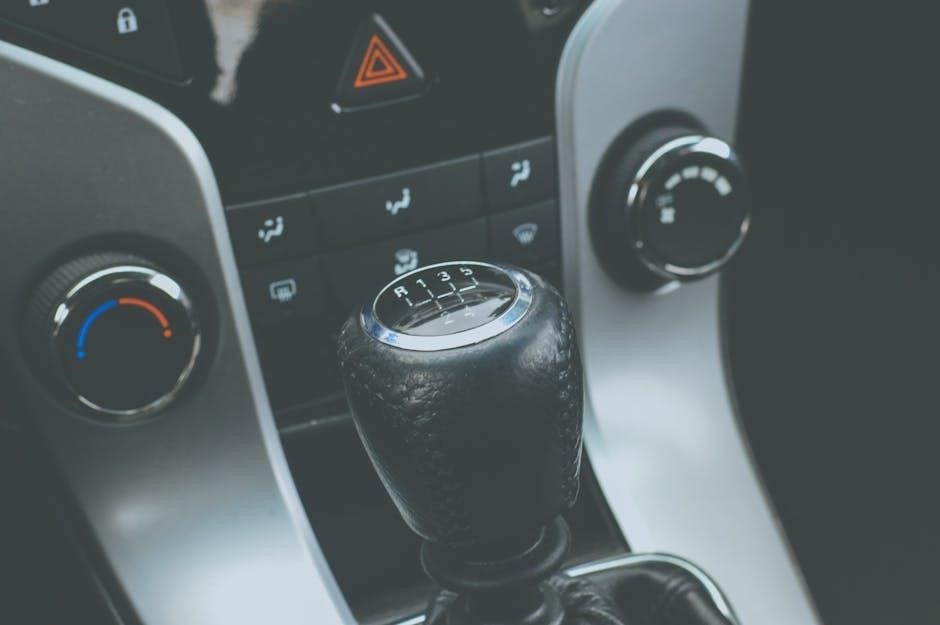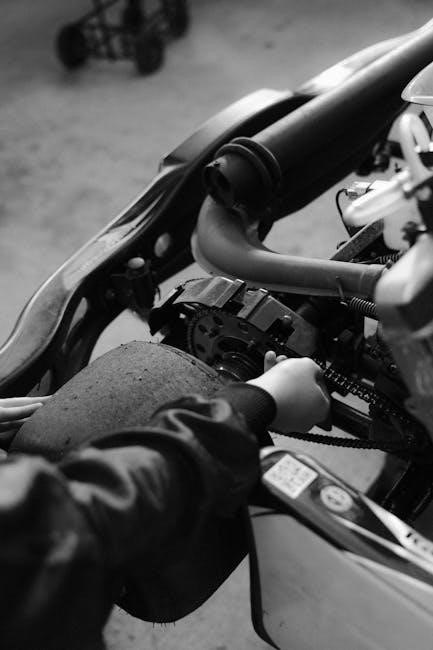Auto-start technology brings convenience to manual car owners, enabling remote engine starts while addressing safety and mechanical challenges through innovative solutions and proper installation procedures.
What is an Auto Start Feature?
An auto start feature, also known as a remote start system, allows drivers to start their car’s engine remotely using a key fob or smartphone app. This convenience enables pre-heating or cooling the vehicle before entry, especially beneficial in extreme weather. While commonly associated with automatic transmissions, manual transmission vehicles can also benefit, provided additional safety measures are in place. The system ensures the car starts only when in neutral gear and with the parking brake engaged, preventing accidental movement. It enhances comfort and safety without compromising the manual driving experience, making it a popular aftermarket addition for car enthusiasts seeking modern convenience paired with traditional driving control.
Benefits of Remote Start for Manual Transmission Vehicles
Remote start systems offer numerous advantages for manual transmission vehicles, enhancing both convenience and comfort. Drivers can start their engines from a distance, ensuring the car is warm in winter or cool in summer, eliminating the need for scraping ice or enduring hot seats. This feature is particularly useful in harsh climates, providing a stress-free start to journeys. Additionally, remote start systems reduce engine wear by allowing the car to warm up properly before driving. They also add a layer of security, as the vehicle remains locked while running. Overall, remote start systems adapt seamlessly to manual transmissions with proper installation, offering a modern convenience without compromising the driving experience traditionally associated with manual cars.
Can You Install a Remote Start on a Manual Car?
Yes, a remote start can be installed on a manual car, but it requires additional safety measures like a clutch bypass and neutral safety switch to ensure proper operation.
Understanding the Challenges
Installing a remote start on a manual car presents unique challenges due to the transmission’s requirements. Unlike automatic vehicles, manual cars need additional safety measures to prevent accidental starts. The system must ensure the car is in neutral and the parking brake is engaged before starting. This often requires a clutch bypass mechanism to simulate clutch engagement, which can complicate the installation process. Furthermore, some manufacturers and installers may hesitate to fit remote starts on manual cars due to these complexities. The anti-theft system must also be compatible to avoid triggering alarms. Proper installation is critical to ensure safety and functionality, as improper setup can lead to unintended engine starts or damage to the vehicle’s systems.
Safety Considerations and Precautions
Ensuring safety is paramount when installing a remote start in a manual car. The system must prevent accidental starts by verifying the car is in neutral and the parking brake is engaged. This requires a clutch bypass mechanism to simulate clutch engagement, preventing grinding gears. Installers must also integrate anti-theft compatibility to avoid triggering alarms. Proper testing is essential to ensure the system shuts down if the brake is pressed or the clutch is engaged. Additionally, users must follow pre-start checks, like setting the parking brake, to avoid vehicle movement. Neglecting these precautions can lead to unintended engine starts, posing risks to people and property. Always adhere to manufacturer guidelines and seek professional help if unsure to maintain safety and system reliability.

Key Considerations Before Installation
Assess compatibility with your vehicle’s make and model, ensure proper safety features like clutch bypass are in place, and consider professional installation help due to complexity.
Why Manual Transmission Cars Require Special Attention
Manual transmission cars demand extra care due to their unique mechanics. Unlike automatics, manuals have a clutch and neutral safety switch, which must be bypassed for remote start. This process ensures the engine doesn’t engage without the clutch being pressed, preventing accidental movement. Specialized wiring and sensors are needed to mimic the clutch action, making installation more complex. Additionally, safety features must be rigorously tested to avoid potential hazards. This complexity is why many manufacturers and installers hesitate to offer remote start systems for manual vehicles, emphasizing the need for expert installation and thorough safety checks to maintain reliability and functionality.
Neutral Safety Switch and Clutch Bypass
The neutral safety switch ensures the vehicle starts only when in neutral, preventing accidental movement. For manual cars, a clutch bypass is required to simulate clutch engagement, allowing the engine to start remotely. This bypass connects to the remote starter, enabling the system to override the clutch safety mechanism. Proper installation is critical to avoid safety risks, such as the car moving unexpectedly. The neutral safety switch and clutch bypass work together to ensure the remote start operates safely and effectively. These components are essential for manual transmissions, as they prevent unauthorized starting and maintain control over the vehicle’s operation. Their integration is a key aspect of remote start systems for manual cars, ensuring both convenience and safety.

How to Install a Remote Start on a Manual Car
Installing a remote start involves disconnecting the battery, fitting the brain unit, wiring connections, and setting up safety switches to ensure secure and proper functionality.
Disconnecting the Battery for Safety
Disconnecting the battery is the first and most crucial step in installing a remote start system. This ensures no electrical hazards or accidental engine starts during the process. Always locate the negative terminal, which is typically marked with a “-” sign or colored black. Loosen the nut on the terminal clamp and slide it off the post. This prevents any power surges or short circuits while working on the electrical system. Additionally, it safeguards against unintended vehicle movement or engine activation. Consulting the vehicle’s manual for specific battery locations and procedures is highly recommended to avoid complications. Safety should never be compromised during installations.
Installing the Remote Starter Brain
Installing the remote starter brain requires careful placement to ensure optimal performance and safety; Typically, the brain is mounted in a hidden location, such as behind the dashboard or under the seat, to protect it from tampering or damage. Once the location is chosen, secure the unit using screws or adhesive mounts. Connect the brain to the vehicle’s electrical system, following the manufacturer’s wiring diagram. Ensure all connections are tight and insulated to prevent short circuits. The brain acts as the central control unit, managing signals from the remote and interacting with the car’s ignition and safety systems. Proper installation is vital for reliable operation and to prevent electrical issues.
Connecting the Wiring and Sensors
Connecting the wiring and sensors is a critical step in installing a remote start system for a manual car. Begin by consulting the vehicle’s wiring diagram to identify the ignition, starter, and accessory circuits. Connect the remote starter brain to these systems, ensuring all wires are securely attached and insulated to prevent short circuits. The neutral safety switch (NSS) and clutch bypass sensor must be properly integrated to ensure the car only starts in neutral gear. Additional sensors, such as the parking brake sensor, may also need connections to enhance safety. After wiring, test the system to ensure all components communicate correctly and the engine starts only under safe conditions. Proper wiring ensures reliable functionality and prevents potential electrical or mechanical issues.
Setting Up the Clutch Safety Switch
Setting up the clutch safety switch is essential for safely installing a remote start system in a manual car. This switch ensures the engine only starts when the clutch pedal is pressed, preventing accidental starts. Install the switch near the clutch pedal, connecting it to the remote starter brain and the clutch pedal’s wiring. The switch must be configured to signal the remote starter only when the clutch is fully pressed. Test the setup by pressing the clutch and attempting a remote start to ensure proper functionality. Some systems may require bypassing the clutch safety switch, but this should be done cautiously to avoid safety risks. Always follow the manufacturer’s instructions for correct installation and ensure the system operates safely and reliably. This step is critical for maintaining safety in manual transmission vehicles.
Testing the System
After installation, thoroughly test the remote start system to ensure it functions correctly. Start by ensuring the vehicle is in neutral gear and the parking brake is engaged. Press the remote start button and verify the engine starts smoothly. Test the shutdown by pressing the brake pedal or inserting the key into the ignition. Check the anti-grind feature by attempting to start the engine while the car is in gear, ensuring it does not engage. Repeat these tests multiple times under different conditions to confirm reliability. Pay attention to any unusual behavior or error signals from the system. If issues arise, consult the installation manual or contact a professional for assistance. Proper testing ensures the remote start operates safely and efficiently in your manual car.

Using the Remote Start Feature
Activate the remote start by pressing the designated button, ensuring the vehicle is in neutral and the parking brake is engaged for safe operation.
Activating the Remote Start
To activate the remote start on a manual car, press the remote’s designated button. Ensure the vehicle is in neutral gear and the parking brake is engaged. The system will verify these safety conditions before starting the engine. Once activated, the engine will run, but the car will not move due to the neutral gear and brake engagement. Always confirm the vehicle’s status before approaching or driving. This feature enhances convenience while maintaining safety protocols specific to manual transmissions. Users must return to the vehicle and follow proper startup procedures before driving. Remote start systems for manuals require careful operation to ensure functionality and safety.
Shutting Down the Engine Remotely
Shutting down the engine remotely on a manual car involves pressing the remote start button again or using a separate shutdown command. Ensure the vehicle is stationary and in neutral gear with the parking brake engaged. Some systems require pressing and holding the button, while others use a double-click function. Always confirm the engine has stopped before approaching the vehicle. For added safety, some systems automatically shut down if the brake pedal is pressed or the clutch is engaged. Proper shutdown ensures the vehicle remains secure and prevents unintended movement. Remote shutdown adds convenience while maintaining safety, especially in manual transmissions, where additional precautions are necessary to avoid accidental starts or movement.
Special Features for Manual Cars
Remote start systems for manual cars often include specialized features to ensure safe and reliable operation. These features may include clutch bypass modules, neutral safety switches, and anti-grind protection to prevent accidental gear engagement. Some systems offer prep mode, requiring the driver to set the parking brake and shift into neutral before remote starting. Additionally, certain brands like Compustar and Excalibur provide advanced sensors and security measures specifically designed for manual transmissions. These features ensure the engine starts only when the vehicle is secure, enhancing both convenience and safety. By addressing unique challenges, these systems make remote start technology accessible and practical for manual car owners, providing peace of mind and improved functionality.
Benefits of Auto Start on Manual Cars
Auto-start technology offers convenience, comfort, and safety for manual car owners, allowing remote engine starts to warm up the car in extreme weather, reducing engine wear and enhancing overall driving experience.
Convenience in Extreme Weather
Auto-start systems provide unparalleled convenience for manual car owners in harsh weather conditions. During frigid winters, remote starting allows the engine to warm up, defrosting windows and heating the interior without the need to physically start the car. Similarly, in sweltering summers, the air conditioning can be activated remotely, ensuring a cool and comfortable cabin upon entry. This feature is especially beneficial for drivers who face extreme temperatures, eliminating the hassle of scraping ice or enduring a scorching hot interior. By enabling pre-climate control, auto-start systems significantly enhance the overall driving experience, making commutes more comfortable and stress-free.
Reduced Wear and Tear on the Engine
Auto-start systems can help reduce wear and tear on manual car engines by allowing the engine to warm up gradually before driving. This prevents cold engine stress, which can lead to premature wear on components like piston rings and cylinders. By enabling the engine to reach its optimal operating temperature, remote starting ensures proper lubrication of moving parts, reducing friction and potential damage. Additionally, consistent idling during remote start helps maintain steady engine RPM, minimizing strain on the engine and transmission. This feature is particularly beneficial for drivers who frequently start their cars in extreme weather conditions, as it promotes smoother engine operation and extends the vehicle’s lifespan.
Enhanced Comfort and Safety
Auto-start systems significantly enhance comfort and safety for manual car owners. Remote starting allows drivers to warm up their vehicles in extreme weather, ensuring a comfortable cabin temperature without physical effort. This feature is especially beneficial in cold climates, as it defrosts windshields and heats the interior before driving. Safety is improved with automatic shut-off capabilities, such as when the brake pedal is pressed or the key is inserted, preventing unintended engine operation. Some systems also include anti-theft features, adding an extra layer of security. Additionally, remote start ensures the car is ready to drive immediately, reducing the risk of accidents caused by cold engines or harsh weather conditions. This convenience and peace of mind make auto-start a valuable upgrade for manual cars.
Challenges and Risks
Auto-start systems for manual cars pose safety hazards, such as unintended engine starts or bypassing critical safety switches, requiring specialized installation to mitigate risks effectively.
Potential Safety Hazards
Remote start systems on manual cars pose unique risks, such as unintended engine starts if the vehicle isn’t properly secured in neutral with the parking brake engaged. Improper installation can bypass critical safety switches, like the clutch safety switch, increasing the risk of accidental movement. Additionally, carbon monoxide buildup is a hazard if the vehicle is left running in an enclosed space. Electrical malfunctions or faulty sensors can also lead to unexpected engine behavior. These risks highlight the importance of professional installation and strict adherence to safety protocols to prevent accidents or injuries. Balancing convenience with safety is crucial to avoid these potential hazards.
Installation Difficulties
Installing a remote start on a manual car presents unique challenges, primarily due to the need to engage the clutch and ensure the vehicle remains stationary. Unlike automatics, manuals require additional components like a clutch bypass to simulate pressing the clutch for starting. This adds complexity and potential points of failure. Wiring intricacies and proper sensor connections are critical to prevent electrical issues or unintended engine behavior. Ensuring the car is securely in neutral with the parking brake engaged is vital to avoid accidental movement. These challenges often necessitate specialized knowledge or professional expertise, making DIY installation more daunting compared to automatic vehicles. The risk of improper installation leading to safety hazards or system malfunctions further complicates the process, emphasizing the need for careful planning and adherence to manufacturer guidelines.
Aftermarket Solutions
Brands like Compustar and Python offer remote start systems designed for manual transmissions, ensuring safe and convenient engine activation with specialized features to address clutch and neutral safety requirements.
Recommended Brands for Manual Cars
When choosing a remote start system for a manual car, brands like Compustar and Python are highly recommended. These brands specialize in systems designed for manual transmissions, offering advanced features like clutch bypass and neutral safety switches. Compustar’s DAS-II Security Sensor ensures safe operation, while Python’s systems are known for their compatibility with diesel engines and manual vehicles. Both brands provide multi-vehicle support and user-friendly interfaces. They also offer a range of models with varying features, such as smartphone app control and extended range. These systems are engineered to address the unique challenges of manual cars, ensuring reliable and secure remote starting. Always consult the manufacturer’s guidelines to find the best fit for your vehicle.
Features to Look for in a Remote Start System
When selecting a remote start system for a manual car, key features to prioritize include a clutch bypass module and neutral safety switch compatibility. These ensure the engine starts only when the transmission is in neutral, preventing accidental movement. Look for systems with multi-vehicle support, extended range, and smartphone app integration for enhanced convenience. Diesel engine compatibility is crucial if your car runs on diesel. Additionally, choose systems with advanced security sensors, such as Compustar’s DAS-II, to maintain safety. Features like custom start-up timers and adjustable idle speeds can also improve functionality. Ensure the system is designed specifically for manual transmissions to avoid installation complications and ensure reliable performance. Always verify compatibility with your vehicle’s make and model before purchasing.

Maintenance and Troubleshooting
Regular maintenance involves checking the battery, connections, and system settings to ensure proper function. Troubleshooting common issues like non-starting engines or remote failures requires checking neutral and clutch settings, plus wiring integrity.
Regular Maintenance Tips
Regular maintenance is essential to ensure your remote start system functions reliably. Start by checking the battery terminals for corrosion and ensuring all wiring connections are secure. Inspect the neutral safety switch and clutch bypass connections for proper alignment and function. Test the remote start periodically to verify responsiveness and address any delays. Keep the system’s software updated to the latest version, as newer updates often improve performance and security. Additionally, clean the vehicle’s ignition and starter components to prevent wear and tear. Finally, review the owner’s manual for specific maintenance recommendations tailored to your system. Regular checks can prevent unexpected issues and extend the lifespan of your remote start system.
Troubleshooting Common Issues
Common issues with remote starts on manual cars include failure to engage, inconsistent operation, or unexpected shutdowns. First, ensure the vehicle is in neutral and the parking brake is engaged. Check the clutch safety switch for proper alignment, as misalignment can prevent the system from starting. Verify all wiring connections, especially the neutral safety switch and clutch bypass, for secure links. If the system fails to respond, test the remote battery or re-sync the remote with the brain unit. Software glitches can occur, so resetting the system or updating its firmware may resolve the issue. If problems persist, consult a professional installer to identify and repair complex wiring or component failures. Regular system checks can help prevent these issues from arising.
Auto-start technology offers convenience, safety, and comfort for manual car owners, despite installation complexities. Proper setup and maintenance ensure reliability and long-term benefits for drivers.
Final Thoughts on Remote Start for Manual Cars
Remote start systems for manual cars offer undeniable convenience and safety, especially in extreme weather conditions, but require careful installation and adherence to safety protocols. While manufacturers often avoid supporting manual transmissions due to complexities, aftermarket solutions like Compustar and Python provide reliable options. Proper setup, including clutch bypass and neutral safety switches, is crucial to prevent unintended engine engagement. Drivers must prioritize safety, ensuring the vehicle is in neutral and the parking brake is engaged before remote starting; Regular maintenance and troubleshooting are essential to maintain system reliability. Despite challenges, the benefits of enhanced comfort, reduced engine wear, and improved safety make remote start a valuable addition for manual car owners willing to invest in proper installation and upkeep.
FAQs
Common Questions About Remote Start on Manual Cars
- Can I install a remote start on a manual car? Yes, but it requires extra safety precautions and specialized components.
- Is it safe to remote start a manual car? Safety depends on proper installation and use of features like neutral safety switches.
- What brands are recommended for manual cars? Compustar and Python are popular choices for manual transmission vehicles.
- Do I need to bypass the clutch safety switch? Yes, a clutch bypass is necessary to prevent accidental starting in gear.
- Will it work with my car’s existing remote? Most systems integrate with factory remotes for seamless operation.
Common Questions About Remote Start on Manual Cars
Many drivers wonder about the feasibility and safety of remote starts in manual cars. Yes, remote starts can be installed, but they require additional safety measures like neutral safety switches and clutch bypasses. These systems ensure the car doesn’t start in gear, preventing accidents. Compustar and Python are highly recommended brands for manual cars due to their advanced safety features. Installation is possible but complex, often requiring professional expertise. Most remote starters integrate with factory remotes for convenience. While some DIY kits are available, safety risks and compatibility issues make professional installation advisable. Remote starts are especially beneficial in extreme climates, offering convenience without compromising safety when properly installed.
